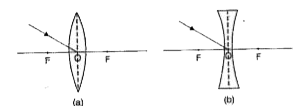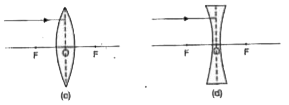A girl was playing with a thin beam of light from a laser torch by directing it from different directions on a convex lens held vertically. She was surprised to see that in a particular direction, the beam of light continues to move along the same direction after passing through the lens. State the reason for her observation. Draw a ray diagram to support your answer.
Step-by-Step Solution
1. Understanding the Setup: The girl is directing a thin beam of light from a laser torch onto a convex lens held vertically. A convex lens is a transparent optical device that converges light rays that are initially parallel to its principal axis.
2. Observation of Light Behavior: The girl notices that in a particular direction, the beam of light continues to move along the same direction after passing through the lens. This means that the light beam does not bend or change direction at that specific point.
3. Identifying the Optical Center: The reason for this behavior is related to the properties of the convex lens. The optical center of the lens is the point where light rays passing through it do not experience any deviation. This is because the lens is symmetrical around this point.
4. Ray Diagram: To illustrate this, we can draw a ray diagram:
- Draw a convex lens with its optical center labeled as 'O'.
- Mark the principal axis, the focus points (F1 and F2), and the points 2F1 and 2F2 on either side of the lens.
- Draw a ray of light that travels parallel to the principal axis and passes through the optical center 'O'. This ray will continue in the same direction after passing through the lens without bending.
5. Conclusion: The light beam continues in the same direction because it passes through the optical center of the lens. At this point, the light ray does not refract, and thus, it travels straight.
Ray Diagram
F1||O(OpticalCenter)||F2
- The ray of light is shown passing through point O, continuing straight without deviation.
- Draw a convex lens with its optical center labeled as 'O'.
- Mark the principal axis, the focus points (F1 and F2), and the points 2F1 and 2F2 on either side of the lens.
- Draw a ray of light that travels parallel to the principal axis and passes through the optical center 'O'. This ray will continue in the same direction after passing through the lens without bending.
- The ray of light is shown passing through point O, continuing straight without deviation.
Similar Questions
A girl was playing with a thin beam of light from a laser torch by directing it form different directions on a convex lens held vertically. She was surprised to see that in a particular direction, the beam of light continues to move along the same direction after passing through the lens. State the reason for the observation. Draw a ray diagram to support your answer.
View SolutionA parallel beam of light of wavelength l is incident normally on a narrow slit. A diffraction pattern is formed on a screen placed perpendicular to the direction of the incident beam. At the second minimum of the diffraction pattern, the phase difference between the rays coming from the two edges of slit is
View Solution
Knowledge Check
When light rays from the sun fall on a convex lens along a direction paralle to its axis
AFocal length for all colours is the sameBFocal length for violet colour is the shortestCFocal length for yellow colour is the longestDFocal length for red colour is the shortestParallel monochromatic beam of light is incident normally on a narrow slit. A diffraction pattern is formed on a screen placed perpendicular to the direction of the incident beam. At the first minimum of the diffraction pattern, the phase difference between the rays coming from the two edges of slit is
AzeroBπCπ2D2πParallel monochromatic beam of light is incident normally on a narrow slit. A diffraction pattern is formed on a screen placed perpendicular to the direction of the incident beam. At the first minimum of the diffraction pattern, the phase difference between the rays coming from the two edges of slit is
AzeroBπCπ2D2π
In each case, given below re-draw the diagram and show the direction of the light ray after refraction from the lens:


View SolutionA student holding a mirror in his hand, directed the reflecting surface of the mirror towards the Sun. He then directed the reflected light on to a sheet of paper held close to the mirror.
Will he be able to determine the approximate value of focal length of this mirror form this activity? Give reason and draw ray diagram to justify your answer in this case.
View SolutionA ray of light is coming along the line y=b from the positive direction of x-axis and striks a concave mirror whose intersection with xy-plane is a parabola y2=4ax. Find the equation of the reflected ray and show that it passes through the focus of the parabola. Both aandb are positive.
View SolutionA parallel monochromatic beam of light is incident normally on a narrow slit. A diffraction patten is formed on a screen placed perpendicular to the direction of incident beam. At the first maximum of the diffraction pattern the phase difference between the rays coming from the edges of the slit is
View SolutionA parallel monochromatic beam of light is incident normally on a narrow slit. A diffraction pattern is formed on a screen placed perpendicular to the direction of the incident beam. At the first minimum of the diffraction pattern, the phase difference between the rays coming from the two edges of the slit is
View Solution
